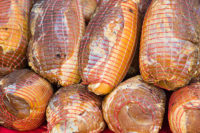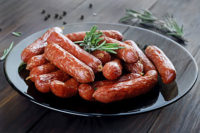Casings: where old- and new-school collide

Casings symbolize centuries of artisanal sausage-making heritage.

Casings’ contribution to lowering processors’ cost of ownership is also strengthened by the predictability their design brings to diameter control for sausage logs.


In an age of sumptuous technologies that preside over so much of our existence, being tagged “old school” is the pseudo-polite way of saying something is out of step, out of touch or, figuratively, past its sell-by date. “New” trumps yesterday, and innovation’s only link is to tomorrow. Even packaging has an old-school poster child: casings. But, thankfully, here is an occasion where perception and reality diverge. Granted, casings symbolize centuries of artisanal sausage-making heritage and, if we fast-forward, today’s players’ roster is virtually the same as 50 years ago. At its base it is an old industry of fibrous collagen and cellulose, but tradition and quality are also the essence of its value. Words such as innovation, engineering and precision generally are not what leap out at you upon hearing “casings,” yet, subtly, the business has become adaptive and innovative.
As in every other segment of meat processing, automation continues to transform sausage making. Now machinability must be engineered into casings because they must auto-feed, cycle, be stuffed, clipped and on top of that create an appealing shape that is repeatable and predictable. To maintain throughput and reduce downtime, fibrous casings manufacturers constantly work to get more and more meters on a strand. There is a significant amount of science and shirring technology needed behind this because in adding more material to a strand, the casings must still be strong and stiff enough to hold shape when stuffed. According to a source, 20 percent more meters on a fibrous strand is achievable and up to 80 percent of that is doable with cellulose and collagen.
Casings’ contribution to lowering processors’ cost of ownership is also strengthened by the predictability their design brings to diameter control for sausage logs. End users expect precise portion control, and it drives everything whether it is sandwich meats or pepperoni. High-yield slicing does not happen if the casing is not stable enough to hold the product to an exact diameter. Common sense tells us the longer the logs, the more usable product. But as they hang, gravity wants to make the bottoms bigger than the tops and casings must be rigid enough to prevent this. It is a delicate balance between machinability and precision.
After successfully contending with the effects of geometry and physics, innovations in this perceived old-school technology also display some sophisticated product adhesion performance. Casings grasp a product and maintain tight contact, helping control rancidity, until they need to be peeled off, leaving behind usable product that is not degraded in any way.
Casings epitomize many of the characteristics associated with value in modern processing. Repeatable and predictable results are only going to be increasingly important because today’s high-volume processing technologies demand them of every kind of packaging material. As always, it is the survival of the fittest, and casings have shown themselves to be very fit. NP
Looking for a reprint of this article?
From high-res PDFs to custom plaques, order your copy today!








